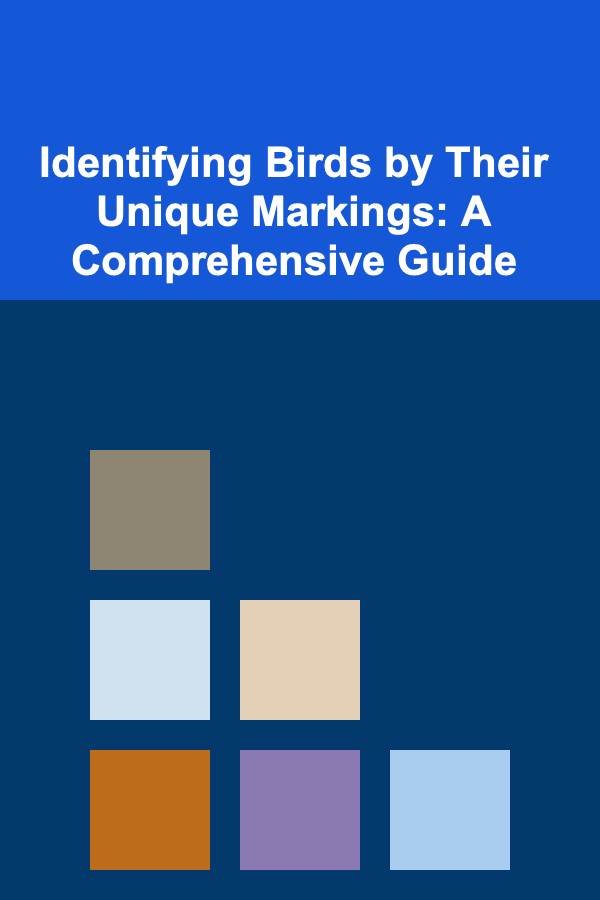
Identifying Birds by Their Unique Markings: A Comprehensive Guide
ebook include PDF & Audio bundle (Micro Guide)
$12.99$7.99
Limited Time Offer! Order within the next:

Birdwatching, or birding, is a rewarding hobby that connects us with the natural world. One of the most fascinating aspects of birding is the ability to identify different species. While size, shape, song, and habitat all contribute to identification, a bird's unique markings are often the key to unlocking its identity. This guide will delve into the intricacies of bird markings, providing you with the knowledge and tools to confidently identify birds based on these distinctive features.
Understanding Bird Topography: The Language of Markings
Before we can effectively use markings for identification, we need a foundational understanding of bird topography -- the specific regions and features of a bird's body. This is like learning the vocabulary of bird identification. Knowing where to look for specific markings is crucial.
- Crown: The top of the head. Markings here can be a solid color, streaked, or feature a crest.
- Nape: The back of the neck. Often a contrasting color or pattern.
- Lore: The area between the eye and the base of the bill. Can be a distinctive color or have a stripe (loreal stripe).
- Supercilium (Eyebrow): A stripe above the eye. Also known as an eyebrow stripe. Its color, length, and thickness are important.
- Eye-line: A stripe through the eye.
- Ear Coverts (Auriculars): The feathers covering the ear opening. These can form a distinct patch or blend with the surrounding plumage.
- Malar Stripe (Mustache Stripe): A stripe running down from the base of the bill along the cheek.
- Chin: The area below the bill.
- Throat: The area below the chin and above the breast.
- Breast: The upper chest area. Markings here can include spots, streaks, bars, or a solid color.
- Belly (Abdomen): The lower chest area, extending towards the vent.
- Flanks: The sides of the body between the breast and the tail.
- Vent: The area around the cloaca (the bird's single opening for excretion and reproduction).
- Back: The upper surface of the body, from the nape to the base of the tail.
- Wings: Composed of several types of feathers:
- Primaries: The outermost flight feathers, crucial for propulsion.
- Secondaries: The inner flight feathers, contributing to lift.
- Wing Bars: Distinct bands of color across the folded wing, formed by the tips of the wing coverts.
- Wing Coverts: The small feathers that cover the base of the flight feathers.
- Tail: The feathers extending from the rear of the bird. The tail shape and any markings (e.g., spots, bars, notches) are important.
- Rump: The area just above the tail.
- Bill (Beak): The shape, size, and color of the bill are vital clues.
- Legs and Feet: Leg color and foot structure can also aid in identification.
Familiarizing yourself with these terms is the first step towards deciphering the language of bird markings.
Types of Markings and Patterns
Bird markings come in a vast array of patterns and colors. Understanding the common types of markings will significantly improve your identification skills. These markings can be broadly categorized as follows:
Color
Color is often the most immediately noticeable aspect of a bird's plumage. Note the specific shades (e.g., olive-green, rusty-red, cobalt-blue) and the distribution of colors across the bird's body. Consider the following:
- Overall Plumage Color: Is the bird primarily brown, gray, black, white, or a combination of these?
- Color Patches: Are there specific areas of bright color, such as a yellow throat, a red cap, or blue wings? The location and size of these patches are important.
- Iridescence: Some birds have iridescent feathers that shimmer with different colors depending on the angle of light. This is common in hummingbirds and some blackbirds.
Streaking
Streaks are narrow, elongated markings that run parallel to each other. They can be found on various parts of the body, including the crown, back, breast, and flanks.
- Location: Where are the streaks located? Are they only on the breast, or do they extend down the flanks?
- Color: What color are the streaks? Are they dark brown, black, or a lighter color against a darker background?
- Density: How dense are the streaks? Are they closely spaced or widely scattered?
- Contrast: How much contrast is there between the streaks and the background color?
Spots
Spots are small, rounded markings. They can be scattered randomly or arranged in a specific pattern.
- Size: Are the spots large or small?
- Shape: Are the spots perfectly round or more irregular in shape?
- Color: What color are the spots?
- Location: Where are the spots located? For example, a spotted breast is common in thrushes.
- Density: Are the spots numerous and close together, or sparse?
Bars
Bars are transverse stripes that run across the feathers. They are often seen on the wings and tail.
- Wing Bars: These are formed by contrasting colors on the tips of the wing coverts. The number, width, and color of wing bars are important identification features.
- Tail Bars: These are stripes that run across the tail feathers. The number and width of tail bars can vary between species.
- Other Barring: Some birds have barring on their flanks or back.
Eye-rings and Facial Markings
The area around the eye and the markings on the face are often highly distinctive and crucial for identification.
- Eye-ring: A ring of contrasting color around the eye. It can be complete or broken (partial). The color and width are important.
- Eyebrow (Supercilium): A stripe above the eye. Its color, length, and thickness are important.
- Eye-line: A stripe through the eye.
- Loreal Stripe: A stripe between the eye and the base of the bill.
- Malar Stripe (Mustache Stripe): A stripe running down from the base of the bill along the cheek.
Throat Patterns
The markings on the throat can also be very distinctive.
- Bib: A patch of contrasting color on the throat, often black.
- Streaking or Spotting: The throat may be streaked or spotted.
- Solid Color: The throat may be a solid color that contrasts with the breast.
Bill and Leg Color
While not technically "markings," the color of the bill and legs can be incredibly helpful in distinguishing between similar species.
- Bill Color: Note the color of the upper and lower mandibles (the upper and lower parts of the bill). Some birds have bills that change color during the breeding season.
- Leg Color: Common leg colors include pink, yellow, black, and gray.
The Importance of Context: Combining Markings with Other Clues
While unique markings are powerful identification tools, it's essential to consider them in the context of other clues. Relying solely on markings can lead to misidentification. Consider the following factors:
Size and Shape
Before focusing on markings, assess the overall size and shape of the bird. Is it small and slender like a warbler, or large and stocky like a hawk? Note the length of the tail, the shape of the wings, and the posture of the bird.
Habitat
Where are you seeing the bird? Different species are adapted to different habitats. Knowing the typical habitat of a species can narrow down the possibilities. For example, a bird found in a dense forest is less likely to be a shorebird.
Behavior
Observe the bird's behavior. How does it move? How does it feed? Does it forage on the ground, in trees, or in the air? Does it fly in a straight line or with an undulating motion? Certain behaviors are characteristic of certain species.
Song and Calls
Bird songs and calls are often unique to each species. Learning to identify birds by their vocalizations is a valuable skill. Many online resources provide recordings of bird songs and calls.
Geographic Location and Time of Year
Knowing the geographic range of a species is crucial. A bird seen outside its normal range is likely to be a vagrant, which should be considered, but with caution. Also, consider the time of year. Many birds have different plumage in breeding and non-breeding seasons. Juvenile birds often have different plumage than adults.
Examples of Identification Using Markings
Let's look at some specific examples of how markings can be used to identify birds:
Example 1: The Yellow-rumped Warbler
The Yellow-rumped Warbler is a common warbler that is relatively easy to identify due to its distinctive markings. The most prominent marking is, of course, the yellow rump patch. This yellow patch is present in both male and female birds, and in all seasons (although it may be less bright in winter plumage). Other key markings include:
- Yellow patches on the sides of the breast (often called "armpits").
- A generally gray-brown back.
- White undertail coverts.
While the male Yellow-rumped Warbler has more distinct markings during breeding season (including a black face mask), the yellow rump patch is a constant identifier, making it a reliable feature for identification year-round.
Example 2: The Downy Woodpecker vs. the Hairy Woodpecker
The Downy Woodpecker and Hairy Woodpecker are two similar-looking woodpeckers that are often confused. While size is a key difference (the Hairy Woodpecker is noticeably larger), markings can also help distinguish them. Look closely at the outer tail feathers. The Downy Woodpecker has black barring on its white outer tail feathers, while the Hairy Woodpecker has plain white outer tail feathers (no barring). Additionally, the Hairy Woodpecker's bill is noticeably longer in proportion to its head than the Downy Woodpecker's.
Example 3: The American Robin
The American Robin is a well-known bird, but let's examine its markings to illustrate the principles discussed. The most distinctive marking is the rusty-orange breast. Other key markings include:
- A dark gray to black head and back.
- A broken white eye-ring.
- Streaking on the throat (more prominent in juveniles).
The combination of these markings, along with the robin's characteristic hopping behavior and its preference for lawns and gardens, makes it a readily identifiable bird.
Tips for Improving Your Bird Identification Skills
Identifying birds by their markings takes practice and patience. Here are some tips to help you improve your skills:
- Start with Common Birds: Focus on learning the markings of the birds that are common in your area. This will give you a solid foundation.
- Use Field Guides: Invest in a good field guide that includes detailed descriptions and illustrations of bird markings. Pay attention to the key identification points for each species. Consider guides specific to your geographic region.
- Take Notes: When you see a bird, take detailed notes on its appearance, including its size, shape, color, markings, habitat, and behavior. Draw a sketch if you can.
- Take Photos: Digital photography has revolutionized birding. Take as many photos as possible, even if they are not perfect. Photos can be invaluable for later identification.
- Use Birding Apps: Several birding apps are available for smartphones and tablets. These apps can help you identify birds based on photos, songs, and descriptions.
- Join a Birding Group: Birding groups offer opportunities to learn from experienced birders and share your observations.
- Practice Regularly: The more you practice, the better you will become at identifying birds. Even short periods of birdwatching can be beneficial.
- Be Patient: Bird identification can be challenging, especially when dealing with similar species or birds in unusual plumage. Don't get discouraged if you make mistakes. Learn from your errors and keep practicing.
- Focus on Key Features: Don't try to memorize every detail of every bird. Instead, focus on the key markings that distinguish each species.
- Use Online Resources: Websites like the Cornell Lab of Ornithology's All About Birds and the Audubon Society's Guide to North American Birds offer a wealth of information on bird identification.
The Ethics of Birdwatching
As birdwatchers, it's important to be mindful of our impact on birds and their habitats. Always practice ethical birdwatching:
- Avoid disturbing nesting birds: Keep a safe distance from nests and avoid making excessive noise.
- Respect private property: Obtain permission before entering private land.
- Minimize your impact on the environment: Stay on trails, avoid trampling vegetation, and pack out all trash.
- Be considerate of other birdwatchers: Share your sightings and avoid monopolizing viewing areas.
- Do not use playback to attract birds excessively: While playback can be useful for attracting birds, overuse can stress them. Use it sparingly and only when necessary.
Conclusion
Identifying birds by their unique markings is a skill that can be developed with practice and dedication. By understanding bird topography, learning the different types of markings, and considering other clues such as size, shape, habitat, and behavior, you can become a confident and skilled birder. Remember to be patient, persistent, and respectful of the birds and their environment. Happy birding!

How to Create a Home Library That Inspires Reading
Read More
How to Plan a Dinner Party with a Casual Vibe
Read More
How to Save Space in Your Kids' Room with Creative Solutions
Read More
Why Organizing Your Outdoor Space Can Enhance Entertaining
Read More
How to Create a Weekly Productivity Checklist for Freelancers
Read More
10 Tips for Preserving Your Foraged Finds
Read MoreOther Products

How to Create a Home Library That Inspires Reading
Read More
How to Plan a Dinner Party with a Casual Vibe
Read More
How to Save Space in Your Kids' Room with Creative Solutions
Read More
Why Organizing Your Outdoor Space Can Enhance Entertaining
Read More
How to Create a Weekly Productivity Checklist for Freelancers
Read More